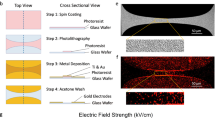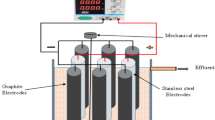Abstract
Bacterial contamination in water is still a critical threat to public health; seeking efficient water disinfection approaches is of great significance. Here we show that locally enhanced electric field treatment (LEEFT) by electrodes modified with nanoscale tip structures can induce ultrafast bacteria inactivation with nanosecond electrical pulses. A lab-on-a-chip device with gold nanowedges on the electrodes is developed for an operando investigation. Attributed to the lightning-rod effect, the bacteria at the nanowedge tips are inactivated by electroporation. A single 20 ns pulse at 55 kV cm−1 has achieved 26.6% bacteria inactivation, with ten pulses at 40 kV cm−1 resulting in 95.1% inactivation. LEEFT lowers the applied electric field by about 8 fold or shortens the treatment time by at least 106 fold, compared with the system without nanowedges. Both Gram-positive and Gram-negative bacteria, including antibiotic-resistant bacteria, are inactivated with nanosecond pulses by LEEFT. According to simulation, when the membrane of the cell located at the nanowedge tip is directly charged by the concentrated charges at the tip, it is charged much faster and to a much higher level, leading to instant electroporation and cell inactivation.
This is a preview of subscription content, access via your institution
Access options
Subscribe to this journal
Receive 12 digital issues and online access to articles
$99.00 per year
only $8.25 per issue
Buy this article
- Purchase on Springer Link
- Instant access to full article PDF
Prices may be subject to local taxes which are calculated during checkout




Similar content being viewed by others
Data availability
The data supporting the findings of this study are available within the paper and Supplementary Information. Source data are provided with this paper. All other data are available from the authors on reasonable request.
Code availability
The scripts for data analysis were developed in MATLAB (version 2021b, MathWorks) and are available from the authors on reasonable request.
References
Supply, W. U. J. W. & Programme, S. M. Progress on Sanitation and Drinking Water: 2015 Update and MDG Assessment (World Health Organization, 2015).
Silvestry-Rodriguez, N., Sicairos-Ruelas, E. E., Gerba, C. P. & Bright, K. R. in Reviews of Environmental Contamination and Toxicology, Vol. 191 (ed. Ware, G.) 23–45 (Springer, 2007).
Chen, W. et al. Silver nanowire-modified filter with controllable silver ion release for point-of-use disinfection. Environ. Sci. Technol. 53, 7504–7512 (2019).
Lemire, J. A., Harrison, J. J. & Turner, R. J. Antimicrobial activity of metals: mechanisms, molecular targets and applications. Nat. Rev. Microbiol. 11, 371–384 (2013).
Li, Q. et al. Antimicrobial nanomaterials for water disinfection and microbial control: potential applications and implications. Water Res. 42, 4591–4602 (2008).
Zheng, K., Setyawati, M. I., Lim, T.-P., Leong, D. T. & Xie, J. Antimicrobial cluster bombs: silver nanoclusters packed with daptomycin. ACS Nano 10, 7934–7942 (2016).
Howe, K. J., Crittenden, J. C., Hand, D. W., Trussell, R. R. & Tchobanoglous, G. Principles of Water Treatment (Wiley, 2012).
Sedlak, D. L. & von Gunten, U. The chlorine dilemma. Science 331, 42–43 (2011).
Zhang, Y., Gu, A. Z., He, M., Li, D. & Chen, J. Subinhibitory concentrations of disinfectants promote the horizontal transfer of multidrug resistance genes within and across genera. Environ. Sci. Technol. 51, 570–580 (2017).
Lu, J. et al. Both silver ions and silver nanoparticles facilitate the horizontal transfer of plasmid-mediated antibiotic resistance genes. Water Res. 169, 115229 (2020).
Operations, U. S. E. P. A. O. O. W. P. Alternative Disinfectants and Oxidants Guidance Manual. Vol. 99 (US Environmental Protection Agency, Office of Water, 1999).
You, J., Guo, Y., Guo, R. & Liu, X. A review of visible light-active photocatalysts for water disinfection: features and prospects. Chem. Eng. J. 373, 624–641 (2019).
Pepper, I. L., Gerba, C. P., Gentry, T. J. & Maier, R. M. Environmental Microbiology (Academic Press, 2011).
Zhou, J., Hung, Y.-C. & Xie, X. Making waves: pathogen inactivation by electric field treatment: from liquid food to drinking water. Water Res. 207, 117817 (2021).
Kotnik, T., Rems, L., Tarek, M. & Miklavčič, D. Membrane electroporation and electropermeabilization: mechanisms and models. Annu. Rev. Biophys. 48, 63–91 (2019).
Tieleman, D. P., Leontiadou, H., Mark, A. E. & Marrink, S.-J. Simulation of pore formation in lipid bilayers by mechanical stress and electric fields. J. Am. Chem. Soc 125, 6382–6383 (2003).
Huang, K. & Wang, J. Designs of pulsed electric fields treatment chambers for liquid foods pasteurization process: a review. J. Food Eng. 95, 227–239 (2009).
Wang, T., Brown, D. K. & Xie, X. Operando investigation of locally enhanced electric field treatment (LEEFT) harnessing lightning-rod effect for rapid bacteria inactivation. Nano Lett. 22, 860–867 (2021).
Liu, C. et al. Conducting nanosponge electroporation for affordable and high-efficiency disinfection of bacteria and viruses in water. Nano Lett. 13, 4288–4293 (2013).
Zhou, J., Wang, T., Chen, W., Lin, B. & Xie, X. Emerging investigator series: locally enhanced electric field treatment (LEEFT) with nanowire-modified electrodes for water disinfection in pipes. Environ. Sci. Nano 7, 397–403 (2020).
Zhou, J., Wang, T. & Xie, X. Locally enhanced electric field treatment (LEEFT) promotes the performance of ozonation for bacteria inactivation by disrupting the cell membrane. Environ. Sci. Technol. 54, 14017–14025 (2020).
Huo, Z.-Y. et al. A Cu3P nanowire enabling high-efficiency, reliable, and energy-efficient low-voltage electroporation-inactivation of pathogens in water. J. Mater. Chem. A 6, 18813–18820 (2018).
Zhou, J., Wang, T., Yu, C. & Xie, X. Locally enhanced electric field treatment (LEEFT) for water disinfection. Front. Environ. Sci. Eng 14, 78 (2020).
Huo, Z.-Y. et al. Nanowire-modified three-dimensional electrode enabling low-voltage electroporation for water disinfection. Environ. Sci. Technol. 50, 7641–7649 (2016).
Cui, S., Chen, S., Wang, H., Dong, L. & Wang, S. N-doped carbon-coated Cu7S4 nanowires on Cu foam supports for water disinfection. ACS Appl. Nano Mater. 4, 6124–6134 (2021).
Wang, S. et al. Hierarchical Cu2O nanowires covered by silver nanoparticles-doped carbon layer supported on Cu foam for rapid and efficient water disinfection with lower voltage. Chem. Eng. J. 382, 122855 (2020).
Pi, S.-Y. et al. Fabrication of polypyrrole nanowire arrays-modified electrode for point-of-use water disinfection via low-voltage electroporation. Water Res. 207, 117825 (2021).
Huo, Z.-Y. et al. Triboelectrification induced self-powered microbial disinfection using nanowire-enhanced localized electric field. Nat. Commun. 12, 3693 (2021).
Xie, X. et al. Nanostraw–electroporation system for highly efficient intracellular delivery and transfection. ACS Nano 7, 4351–4358 (2013).
Vecitis, C. D., Zodrow, K. R., Kang, S. & Elimelech, M. Electronic-structure-dependent bacterial cytotoxicity of single-walled carbon nanotubes. ACS Nano 4, 5471–5479 (2010).
Wang, T., Chen, H., Yu, C. & Xie, X. Rapid determination of the electroporation threshold for bacteria inactivation using a lab-on-a-chip platform. Environ. Int. 132, 105040 (2019).
Elbourne, A. et al. Antibacterial liquid metals: biofilm treatment via magnetic activation. ACS Nano 14, 802–817 (2020).
Gao, F., Shao, T., Yu, Y., Xiong, Y. & Yang, L. Surface-bound reactive oxygen species generating nanozymes for selective antibacterial action. Nat. Commun. 12, 745 (2021).
Loraine, G., Chahine, G., Hsiao, C.-T., Choi, J.-K. & Aley, P. Disinfection of Gram-negative and Gram-positive bacteria using DynaJets® hydrodynamic cavitating jets. Ultrason. Sonochem. 19, 710–717 (2012).
Virto, R., Manas, P., Alvarez, I., Condon, S. & Raso, J. Membrane damage and microbial inactivation by chlorine in the absence and presence of a chlorine-demanding substrate. Appl. Environ. Microbiol. 71, 5022–5028 (2005).
Slavin, Y. N., Asnis, J., Häfeli, U. O. & Bach, H. Metal nanoparticles: understanding the mechanisms behind antibacterial activity. J. Nanobiotechnol. 15, 65 (2017).
Zhang, T. et al. Inactivation of bacteria by peracetic acid combined with ultraviolet irradiation: mechanism and optimization. Environ. Sci. Technol. 54, 9652–9661 (2020).
Huang, X. et al. Investigation of functional selenium nanoparticles as potent antimicrobial agents against superbugs. Acta Biomater. 30, 397–407 (2016).
Li, R. et al. Surface oxidation of graphene oxide determines membrane damage, lipid peroxidation, and cytotoxicity in macrophages in a pulmonary toxicity model. ACS Nano 12, 1390–1402 (2018).
Kotnik, T., Bobanović, F. & Miklavčič, D. Sensitivity of transmembrane voltage induced by applied electric fields—a theoretical analysis. Bioelectrochem. Bioenerg. 43, 285–291 (1997).
Zhou, J., Yu, C., Wang, T. & Xie, X. Development of nanowire-modified electrodes applied in the locally enhanced electric field treatment (LEEFT) for water disinfection. J. Mater. Chem. A 8, 12262–12277 (2020).
Xie, X. et al. Three-dimensional carbon nanotube−textile anode for high-performance microbial fuel cells. Nano Lett. 11, 291–296 (2011).
Mai-Prochnow, A., Clauson, M., Hong, J. & Murphy, A. B. Gram positive and Gram negative bacteria differ in their sensitivity to cold plasma. Sci. Rep 6, 38610 (2016).
Boukany, P. E. et al. Nanochannel electroporation delivers precise amounts of biomolecules into living cells. Nat. Nanotechnol. 6, 747–754 (2011).
Sanchis, A. et al. Dielectric characterization of bacterial cells using dielectrophoresis. Bioelectromagnetics 28, 393–401 (2007).
Stratford, J. P. et al. Electrically induced bacterial membrane-potential dynamics correspond to cellular proliferation capacity. Proc. Natl Acad. Sci. USA 116, 9552–9557 (2019).
Shahini, M. & Yeow, J. T. Cell electroporation by CNT-featured microfluidic chip. Lab Chip 13, 2585–2590 (2013).
Acknowledgements
The authors acknowledge the financial support from the National Science Foundation (grant number CBET 1845354). This work was performed in part at the Georgia Tech Institute for Electronics and Nanotechnology, a member of the National Nanotechnology Coordinated Infrastructure (NNCI), which is supported by the National Science Foundation (grant ECCS-2025462). T.W. is grateful for the financial support provided by the China Scholarship Council. T.W. also thanks X. Li for her assistance on the drawing included in Fig. 4.
Author information
Authors and Affiliations
Contributions
X.X. and T.W. designed the research. T.W. performed the research. T.W. and X.X. analysed the data and wrote the paper.
Corresponding author
Ethics declarations
Competing interests
The authors declare no competing interests.
Peer review
Peer review information
Nature Water thanks the anonymous reviewers for their contribution to the peer review of this work.
Additional information
Publisher’s note Springer Nature remains neutral with regard to jurisdictional claims in published maps and institutional affiliations.
Supplementary information
Supplementary Information
Supplementary Methods, Discussion and Figs. 1–12.
Supplementary Data
Source data for supplementary figures.
Source data
Source Data Fig. 1
Source data.
Source Data Fig. 2
Statistical source data.
Source Data Fig. 3
Statistical source data.
Source Data Fig. 4
Source data.
Rights and permissions
Springer Nature or its licensor (e.g. a society or other partner) holds exclusive rights to this article under a publishing agreement with the author(s) or other rightsholder(s); author self-archiving of the accepted manuscript version of this article is solely governed by the terms of such publishing agreement and applicable law.
About this article
Cite this article
Wang, T., Xie, X. Nanosecond bacteria inactivation realized by locally enhanced electric field treatment. Nat Water 1, 104–112 (2023). https://doi.org/10.1038/s44221-022-00003-2
Received:
Accepted:
Published:
Issue Date:
DOI: https://doi.org/10.1038/s44221-022-00003-2



